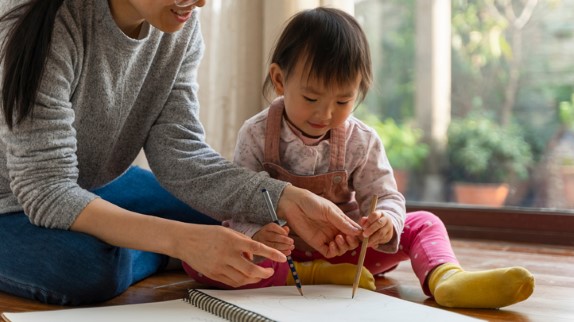Just as your baby’s curls or brown eyes are a part of her genetic code, whether she’ll be left- or right-handed is based, in part, on her DNA. But as you observe your child in her everyday activities, it may be hard to tell which hand will come out on top.
In fact, very young infants don’t normally show a preference for being right- or left-handed. And as your baby learns to reach, grab and grasp, she’ll probably continue to make several swaps back and forth with the object in her hands. And outside factors influence handedness, such as your baby’s prenatal environment and the culture she’s raised in.
Here’s more about toddler hand preferences, including when a child develops a clear hand choice on one side and how it happens.
What is a dominant hand?
A dominant hand is the one that’s stronger and nimbler when it comes to dexterity, while a child’s non-dominant hand is weaker and less adept at everyday tasks, like eating, throwing a ball and building a block tower. If you were to base dominant handedness on statistics, it's far more likely that your toddler will be a righty, along with 85 to 90 percent of the population.
Only around 10 to 15 percent of people are lefties (and about 1 percent are ambidextrous, showing no preference for their left or right hand, and using both). Wondering what hand your cutie will prefer? As it turns out, hand preference isn’t easy to trace down the family tree.
Children with left-handed parents are more likely to be lefty than kids with right-handed moms and dads, and researchers think that heredity accounts for about 25 percent of a person’s chances of becoming left-handed. But because the chance of left-handedness is so slim, most toddlers of left-handed parents end up using their right hands.
Read This Next
How and when do children develop handedness?
Many children don't show a clear preference until age 3 or older. Until then, don't be surprised if you notice some back and forth.
Some children appear to favor one hand for a while and then switch (and possibly back again) as they figure out, through trial and error, which hand is easier to use. Some kids even separate tasks — using the right hand to throw a ball, for example, and the left hand for eating with a spoon.
Wondering if you should try do anything to encourage your little one to use one hand over the other? Remember that nature is mostly at work here, with hand preference likely developing before birth. In fact, in a small study of thumb sucking and handedness among fetuses, unborn babies who sucked their right thumbs in utero ended up becoming righties later in life.
And since forcing a child to use one hand over the other is thankfully a thing of the past, it’s best to just sit back and watch nature take its course. You’ll notice that by age 3 or 4, when toddlers are performing more fine-motor activities, handedness will become much more obvious.
How to tell if a child is left- or right-handed
While you can’t control whether your child will be left- or right-handed, you might be able to tell which way she’s leaning by offering her a range of interesting toys (think colorful, textured, squeaky) to encourage her grasping, grabbing and reaching skills. Allow her to swap items back and forth until she finally lands on the side that’s most comfortable for her.
Of course, every child develops at her own speed, so try not to worry about handedness in your toddler. But if your tot strongly favors one hand before she turns 18 months old, let the doctor know. In rare cases, an early and consistent preference could signal a neurological problem.
The development of handedness is an innate trait that’s also influenced by what your toddler experiences and sees around the house. But while your tot may mimic the way you hold your fork, ultimately, she’ll decide which hand is best for getting those carrots into her mouth.




 Trending On What to Expect
Trending On What to Expect






